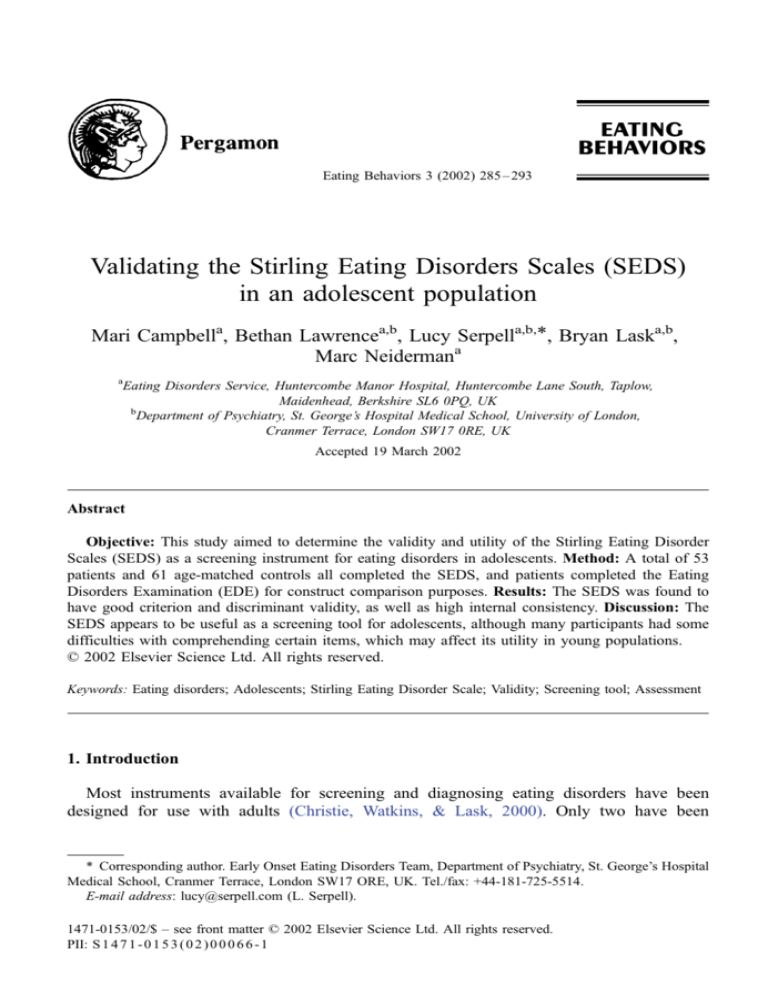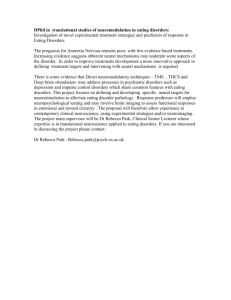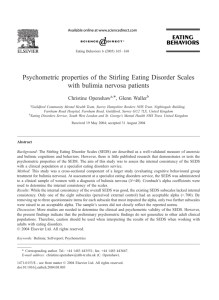
Eating Behaviors 3 (2002) 285 – 293
Validating the Stirling Eating Disorders Scales (SEDS)
in an adolescent population
Mari Campbella, Bethan Lawrencea,b, Lucy Serpella,b,*, Bryan Laska,b,
Marc Neidermana
a
Eating Disorders Service, Huntercombe Manor Hospital, Huntercombe Lane South, Taplow,
Maidenhead, Berkshire SL6 0PQ, UK
b
Department of Psychiatry, St. George’s Hospital Medical School, University of London,
Cranmer Terrace, London SW17 0RE, UK
Accepted 19 March 2002
Abstract
Objective: This study aimed to determine the validity and utility of the Stirling Eating Disorder
Scales (SEDS) as a screening instrument for eating disorders in adolescents. Method: A total of 53
patients and 61 age-matched controls all completed the SEDS, and patients completed the Eating
Disorders Examination (EDE) for construct comparison purposes. Results: The SEDS was found to
have good criterion and discriminant validity, as well as high internal consistency. Discussion: The
SEDS appears to be useful as a screening tool for adolescents, although many participants had some
difficulties with comprehending certain items, which may affect its utility in young populations.
D 2002 Elsevier Science Ltd. All rights reserved.
Keywords: Eating disorders; Adolescents; Stirling Eating Disorder Scale; Validity; Screening tool; Assessment
1. Introduction
Most instruments available for screening and diagnosing eating disorders have been
designed for use with adults (Christie, Watkins, & Lask, 2000). Only two have been
* Corresponding author. Early Onset Eating Disorders Team, Department of Psychiatry, St. George’s Hospital
Medical School, Cranmer Terrace, London SW17 ORE, UK. Tel./fax: +44-181-725-5514.
E-mail address: lucy@serpell.com (L. Serpell).
1471-0153/02/$ – see front matter D 2002 Elsevier Science Ltd. All rights reserved.
PII: S 1 4 7 1 - 0 1 5 3 ( 0 2 ) 0 0 0 6 6 - 1
286
M. Campbell et al. / Eating Behaviors 3 (2002) 285–293
adequately modified for use with children and adolescents: (1) The Children’s Eating
Attitudes Test (Ch-EAT), developed by Maloney, McGuire, and Daniels (1988) and based
on the Eating Attitudes Test (EAT) (Garner & Garfinkel, 1979), has demonstrated good
concurrent validity, test–retest validity, and internal consistency. (2) The Kids’ Eating
Disorders Survey (KEDS) was developed from the Eating Symptoms Inventory (ESI,
Whittaker et al., 1989) and was based on DSM-III criteria (American Psychiatric Association,
1980) to address the marked differences in cognitive development between children and
adults. Used as a screening device within the general population, it has good test–retest
reliability (Childress, Brewerton, Hodges, & Jarrel, 1993).
The Stirling Eating Disorders Scales (SEDS), developed by Williams et al. (1994), is a
self-report instrument devised to screen and assess the cognitive and behavioural features of
anorexia nervosa (AN) and bulimia nervosa (BN), as well as some of the commonly
associated features. The SEDS consists of 80 statements, all requiring a true/false answer.
These statements are divided into eight subscales—four ‘‘dietary’’ subscales: ‘‘anorexic
dietary cognitions,’’ ‘‘anorexic dietary behaviours,’’ ‘‘bulimic dietary cognitions,’’ and
‘‘bulimic dietary behaviours’’; and four ‘‘nondietary’’ subscales: ‘‘perceived external control,’’ ‘‘low assertiveness,’’ ‘‘low self-esteem,’’ and ‘‘self-directed hostility.’’ Each subscale
has a threshold, determined during the development of the questionnaire. If a respondent
scores above the threshold on a subscale, this indicates that they may have some of the
features of AN or BN, and require further assessment.
The SEDS psychometric properties were established by presenting it in three groups: AN
(n = 38, mean age 24.7 years, mean weight 45.9 kg), BN (n = 36; mean age 25.0 years, mean
weight 62.9 kg) and a normal control group (n = 68, mean age 23.8 years, mean weight 62.5
kg.) Acceptable levels of internal consistency, reliability, group validity, and concurrent
validity were demonstrated (Williams et al., 1994).
The SEDS is commonly administered to children and young adolescents despite the fact
that it was not specifically designed nor validated for use in this age group. The aim of this
study was to determine the validity and utility of the SEDS in a younger population.
2. Method
2.1. Participants
A total of 53 patients (51 females, 2 males; mean age 15.6) referred to two specialist eating
disorder services (Huntercombe Manor Hospital, Berkshire, and St. George’s Hospital,
London) completed the SEDS as part of initial assessment. Sixty-one age-matched nonclinical
controls (55 females, 6 males; mean age 15.4) were recruited from two local secondary schools.
The mean Body Mass Index (BMI) was 16.6 for the patients and 20.6 for the controls. Ethnicity
was also recorded for both groups: 94.3% of the patients were ‘‘White’’ and 5.7% were
classified as ‘‘Other,’’ whilst 65.6% of the controls were ‘‘White’’ and 34.4% were classified as
‘‘Other.’’ DSM-IV diagnoses in the clinical group were 41.5% AN, 3.8% BN, and 54.7% eating
disorder not otherwise specified (EDNOS) (American Psychiatric Association, 1994).








